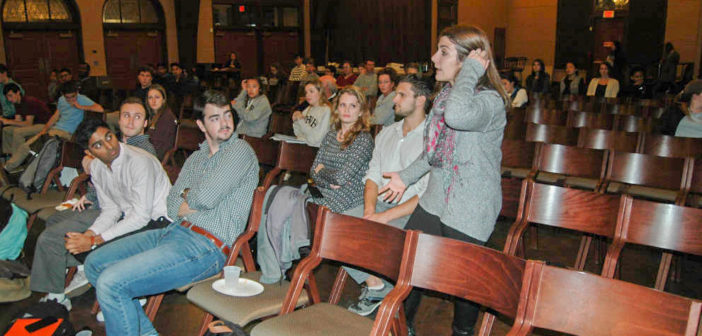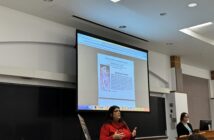Lehigh’s College Democrats and College Republicans held a debate to discuss issues on society, healthcare, the economy, national security and immigration at Lamberton Hall on Monday.
The debate was entirely student-run and was organized by the political science honor society, Pi Sigma Alpha, in collaboration with the College Democrats, College Republicans and the political science department. Preparation for the event began in September and was spearheaded by Pi Sigma Alpha.
“We wanted to have an event that raised political awareness on campus,” said Amanda Donohue, ’17, the president of the honor society.
She said the society wanted to have students share their opinions, and thought presenting a student perspective would be useful during this election.
The Democratic and Republican panels each consisted of three students, ranging between first-years and seniors.
Every statement made reflected the student’s personal views. A student panel moderated the debate and allowed four to five minutes for open debate after each topic, as well as five minutes for audience participation.
The moderators created and asked questions during the debate, which began with questions about the economy and expanded to other social and security issues.
Members of the opposing parties, as well as individual panelists, expressed many differing perspectives throughout the debate.
College Democrats, for example, argued American infrastructure is crumbling and that the wealthy need to pay their fair share of taxes. They also argued there should be increased state spending toward higher education and that inequality and the gender gap are major issues in our society.
Some of the College Republicans’ main arguments included the government is spending too much money it doesn’t have and illegal immigration needs to be reviewed and reformed.
Despite several disagreements, there were also some issues that members of both parties agreed upon, including equality in the workforce, increased funding for vocational training, the maintenance of relations with allies, issues with Obamacare and the need for more gun control regulations.
Audience member Alexis Mims, ’18, said she was shocked at the amount of common ground the two parties shared during the debate.
“I was surprised to see that many of the students on the Democratic and Republican side openly agreed on many issues,” Mims said.
Some points of contention during the debate surrounded the freezing of student loans, the various approaches toward combating ISIS, abortion rights and the clash of cultures within America.
Jigar Patel, ’17, the president of the College Democrats, said he thought the debate was productive in arguing many of the ideologies and beliefs of each party.
“We wanted the debate to be issues-based,” Patel said. “And because of that, the students were debating the issues themselves.”
Audience participation also fueled the debate. After each topic was debated, audience participants had the chance to ask questions or make comments.
Patel said open audience participation was valuable to the debate.
“People were able to voice their opinions in an open environment,” he said.
Audience commentary included statements about immigration and abortion as well as questions directed at the Democrats or Republicans regarding certain issues.
Max Weiss, ’17, the president of the College Republicans, said the point of the debate was to get people involved and engaged in politics, which he believed it was successful in doing. Weiss said one of the main goals of the debate was to encourage student discussion on the issues, like healthcare, immigration and the economy.
Discussions during the debate would often start on one topic and end up spreading to a different issue. Weiss said this was an unintended result that proved all political issues are interrelated.
Patel said this debate was far different from the debates on television.
“Usually debates on TV are not issues-based — they just talk about each other,” he said.
Patel said the debate allowed the audience to vocalize their opinions about what issues they support, rather than whom they support in the upcoming election.
Audience members had positive feedback about the debate.
Sabrina Schulman, ’18, a member of Pi Sigma Alpha, thought it was productive and interesting. She said the debate gave her a fresh perspective on many current issues that she was unaware related to the election season. She thought it was interesting and useful to hear student opinions from both parties.
“I liked how everyone was able to remain respectful and focus on issues-based questions instead of just fighting about both candidates,” she said.






Comment policy
Comments posted to The Brown and White website are reviewed by a moderator before being approved. Incendiary speech or harassing language, including comments targeted at individuals, may be deemed unacceptable and not published. Spam and other soliciting will also be declined.
The Brown and White also reserves the right to not publish entirely anonymous comments.
2 Comments
I’m not surprised by the considerable agreement between the two sides. Today’s youth have been brainwashed by the leftist propaganda machine since birth. And the indoctrination hasn’t slowed down any at Lehigh.
I do find the photo caption amusing where it says:
“McMichael identifies as a Democrat and also holds Libertarian views.” I cannot conceive of her being both when it comes to the fundamental beliefs and visions of these two parties.
They are as far apart as the concepts of “affirmative action” and “equal opportunity”.
Affirmative action is, of course, a blatantly racist spoils system. Whereas equal opportunity implies a level playing field where merit is all that counts.
Sounds like a real debate, which I wound expect from Lehigh students.
I would describe Clinton/Trump as a Shout Down or Character Duel